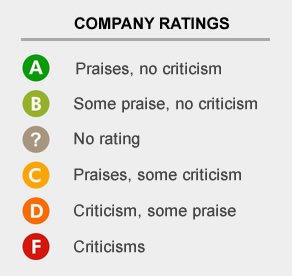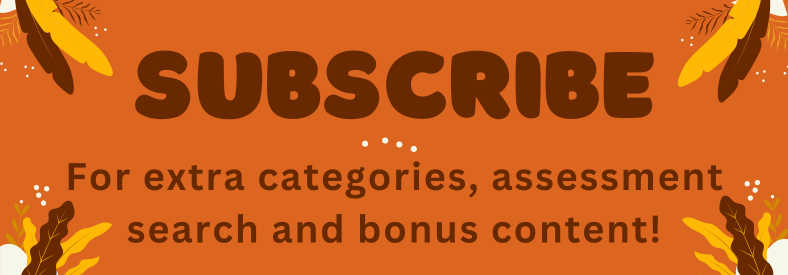Ratings & Assessment
 Shop Ethical! seeks to shed light on the ethical impacts of products and companies by bringing together publically available assessment information in one spot.
Shop Ethical! seeks to shed light on the ethical impacts of products and companies by bringing together publically available assessment information in one spot.
We translate the information from many different assessment sources into a single, easy to read rating from A to F, to help you to choose more ethical options when you shop.
Please note the focus of the Shop Ethical! guide is on a company’s track record, rather than the features of the products themselves. Products with outstanding features are noted however (with a Green Star).
The ratings are not an endorsement or comment upon an individual company or brand, beyond the information gathered. We encourage people to follow the links to the reports themselves and to evaluate the information using their own judgments based on what they value.
Keep reading to find out more about how we determine our ratings.
See also: Ratings upgrade 2025 | Ratings history
1. Methodology
2. Sources criteria
3. Assessment sources
4. Assessment categories
5. Assessment icons decoder
6. Outstanding product features
7. Alternatives beyond the mainstream
8. Limitations
9. Disclaimer
1. Methodology
1. Transparency
We gather assessment information for companies related to common brands. These assessments can be grouped broadly under the areas of environment, social, animals, and business ethics. All assessments are linked to source documents.
2. Weighting
As shown in the table below, assessments weighted Full Praise, Lesser Praise, Lesser Criticism, Full Criticism or Boycott Call count towards a company's rating. Assessments weighted as Minor Praise, Minor Criticism and Neutral do not generally count towards a company’s rating (see below for exceptions).
Weighting is at our discretion.
| Icon | Weighting | Points | Icon | Weighting | Points | |
| Full praise | 2 | Full criticism | -2 | |||
| Lesser praise | 1 | Lesser criticism | -1 | |||
| Minor praise | 0 | Minor criticism | 0 | |||
| Neutral | 0 | Boycott call | F |
3. Rules for calculating ratings
Each company is given a total numerical score, which is calculated by adding up praises and criticisms for a company, including companies up the ownership tree.
Each assessment subcategory (eg. climate change, workers' rights) has a maximum score range of +/- 3 points.
The overall rating is then calculated using the following rules.
| Rating | Tally | Condition | |
| A+ | 5+ | ||
| A | 4 | ||
| A- | 3 | ||
| B+ | 5+ | at least one minor criticism* | |
| B | 2 | ||
| B- | 1 | ||
| ? | 0 | ||
| C+ | 5+ | at least one criticism | |
| C | 2,3,4 | at least one criticism | |
| C- | 0,1 | at least one criticism | |
| D+ | -1 | ||
| D | -2 | ||
| D- | -3 | ||
| F | -4 |
* annual revenue exceeding US$1 billion counts as a minor criticism.
This points system has the following overrides/exceptions:
> Any neutral limits potential rating to A-
> Any minor criticism limits potential rating to B+
> Any full or lesser criticism limits potential rating to C+
> Any boycott call limits potential rating to F
> No full or lesser praises or criticisms but a neutral is rated C
> No full or lesser praises or criticisms but a minor criticism is rated C-
For more detail, click here.
4. Compare
Our Compare Brands pages (eg. Beer) list common brands with their primary related company and parent company in brackets. The primary related company listed is usually the manufacturer. We assume the manufacturer and brand owner are the same unless otherwise stated*. If there are other related companies, these are listed underneath along with the type of relationship (eg. brand owner). The ‘owned’ column indicates where the parent company is headquartered. The ‘rating’ column shows the overall rating of the primary company, including parent companies.
* Exception – For supermarket housebrands the supermarket is most often the brand owner AND the exclusive retailer of a listed product (eg. Coles). In this case that company is listed as the primary related company. The manufacturer, where available, is listed underneath.
2. Sources criteria
We seek sources that are:
- independent and impartial (separate from an organisation’s own claims),
- recognised and reputable (not someone’s blog site),
- systematic and reasonable (have methodology)
All assessments use existing, publicly accessible information. We seek to make this transparent and accessible to the everyday shopper in a way that assists in making positive buying choices. We have used the principles below as a guide for inclusion of assessments. We document where possible the reasons for inclusion if they fall outside those listed below.
Criteria for inclusion:
- Broadly relate to company record under the areas of environment, social, animals, and business ethics.
- Fall into one of three general categories:
- external – independent assessment or critique from a third party (including news reports)
- voluntary covenant – company signs up to an external agreement
- self-disclosure – own reporting managed by third party
- Not older than five years.
Generally if assessments use sources that fall outside these criteria, the assessments are tagged as ‘information’ (rather than ‘praises’ or ‘criticisms’) and so do not count in the calculation of the company-tree rating.
3. Assessment sources
A list of our main assessment sources can be found here.
4. Assessment categories
A list of our assessment categories can be found here.
5. Assessment icons decoder
| Used In Assessment | Environment | Social | Animal | Business Ethics |
| Praise | ||||
| Lesser Praise | ||||
| Lesser Criticism | ||||
| Criticism | ||||
| Boycott Call | ||||
| Not Used In Assessment * | ||||
| Minor Praise | ||||
| Minor Criticism | ||||
| Neutral | ||||
|
* The exception to this rule is: If a company has praises and no criticisms, except minor criticisms, then that company's rating is limited to a 'B+'. Company ratings are also limited to a 'B+' if that company has an annual revenue exceeding one billion dollars. This is consistent with our approach of supporting small local businesses over large multinationals. |
||||
6. Outstanding product features
Products under a brand that have outstanding features are highlighted with a green star. Outstanding ethical or sustainable features include certified organic, FSC Recycled and fair trade. Details can be seen by clicking on the green star.
7. Alternatives beyond the mainstream
Some of the Compare Brands pages include an "Alternatives beyond the mainstream" section, where we list products that are not commonly found in mainstream stores, but have positive features.
Although this guide helps you find better choices within the supermarket or department store, often the most ethical options are found beyond these stores. The "Alternatives" section highlights organisations which offer products with some outstanding features compared to commonly available brands of the same product type.
These organisations are not rated or screened in the same way as others in the Shop Ethical database. Companies in the main Shop Ethical database are available in mainstream outlets, with ratings calculated from related assessments. Organisations in the "Alternatives" section are often small with no assessment information available.
To be included in the "Alternatives" section, a product must fit one of our already existing categories, not be available in mainstream stores, and meet at least one the following criteria:
- product range carries at least one ecolabel, such as Fairtrade, organic, ethical clothing australia
- company holds at least one ecolabel, such as B Corporation, carbon neutral, cruelty-free
- Australian-owned and made
8. Limitations
In making this guide both concise and practical we offer a somewhat simplified version of what is a complex web of company ownership, assessments and related issues. Please view this website as a starting place in developing a greater understanding of the connections between how we act and its effect on the world around us.
Some considerations:
- The company ratings indicate criticisms and/or praises in one or more issue areas in the ownership tree, but not all areas. For most product types there are usually a variety of connected issues that individuals will weight differently according to their own priorities and concerns. For example, it would not be correct to assume a clothing company has a good track record in the area of workers rights simply because it receives a positive rating (it may be for something like using exclusively organic fibre).
- A common misconception is that the guide indicates ‘good’ or ‘bad’, ‘ethical’ or ‘unethical’, companies. In reality companies are ‘more ethical’ or ‘less ethical’ in particular areas depending on what criteria are being focused on. The simplified nature of our ratings system does not adequately reflect this, and is intended as a first-step way to apply the information.
- There is little or no transparency on the conditions behind common processes in most supply chains in many industries. Although having ‘no information’ implies minimal standards are in place, we have not treated ‘no information’ as a ‘criticism’.
- You may note that some large companies tend to rate well given the sources and methodology used. This may be because some sources focus only on large companies or larger companies have more resources to put into sustainability reporting and policy. It could also be that there is limited information available on smaller companies.
It seems unfortunate that a company is seen as ‘outstanding’ because it has commitment to be free from genetically engineered ingredients, or refrains from animal testing, or has made a voluntary agreement to minimise packaging waste. All these things should be normal practice for business however the reality is that these things are often secondary to profit. Common business operation is based on reducing expenses by every possible means which for the most part involves exploitation of our planet, its people, and each of us as consumers.
Let us redefine what can be considered ‘acceptable’ and raise the bar by holding companies to account and so encouraging company responsibility.
9. Disclaimer
This guide seeks firstly to make publicly available information pertaining to a company’s track record available in one place. A second function is to assist consumers in applying this information to their everyday purchasing choices. The ratings in this guide signify that a company in the ownership tree have significant criticisms (or praises with no criticisms) from specific selected sources.
The ratings are not an endorsement or comment upon an individual company or brand, beyond the information gathered. We encourage people to follow the links to the reports themselves and to evaluate the information using their own judgments based on what they value.
All information has been based on the sources referenced with a view to accuracy at time of printing.
The ratings are not an endorsement or comment upon an individual company, beyond the information gathered. We in no way claim that the list of sources used is complete or comprehensive. Rather we seek to make existing information transparent and accessible to the everyday shopper.
We encourage people to follow the links on the website to the reports themselves and to evaluate the information using their own judgments based on what they value.
The Ethical Consumer Group does not accept liability for any error contained in the information.
Please contact us with any comments or updates



